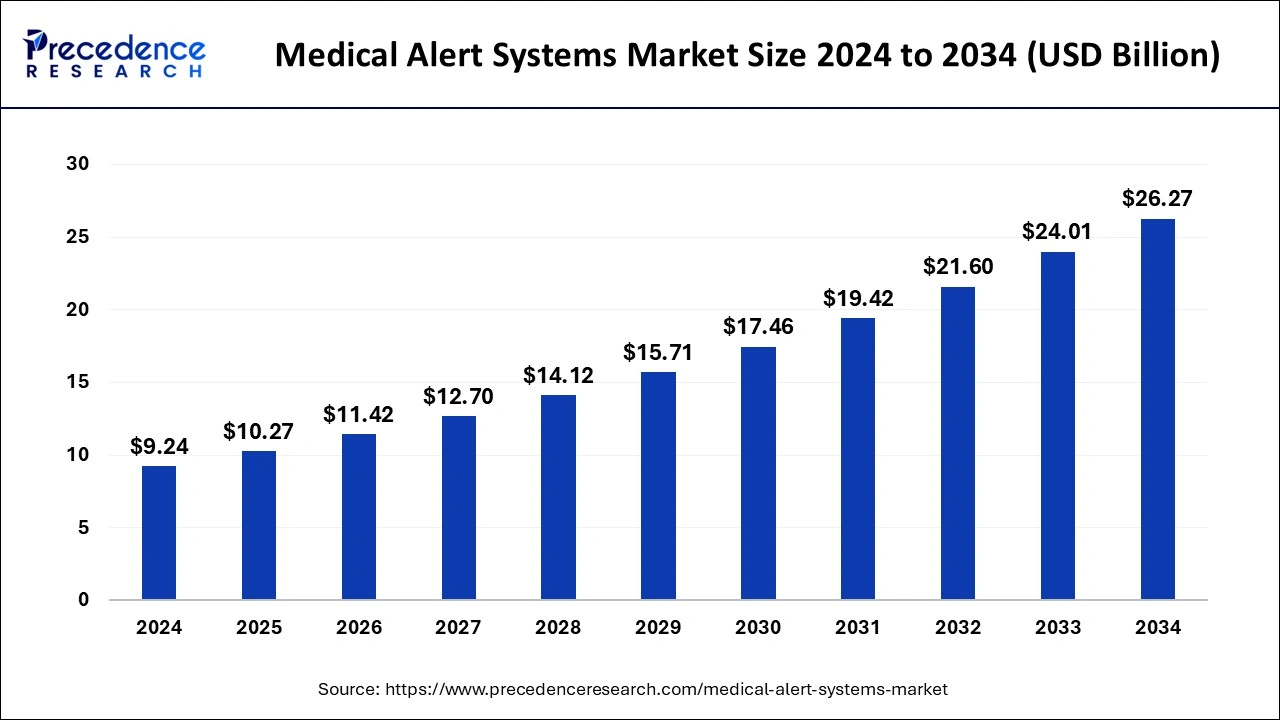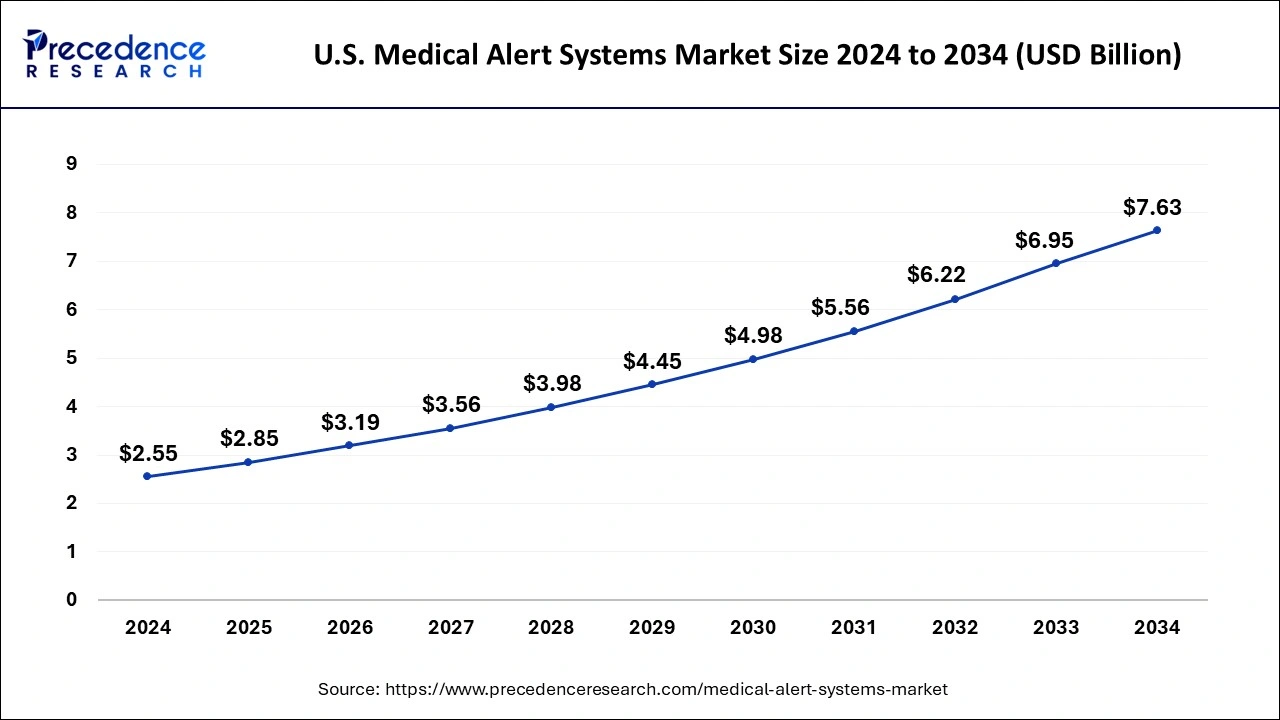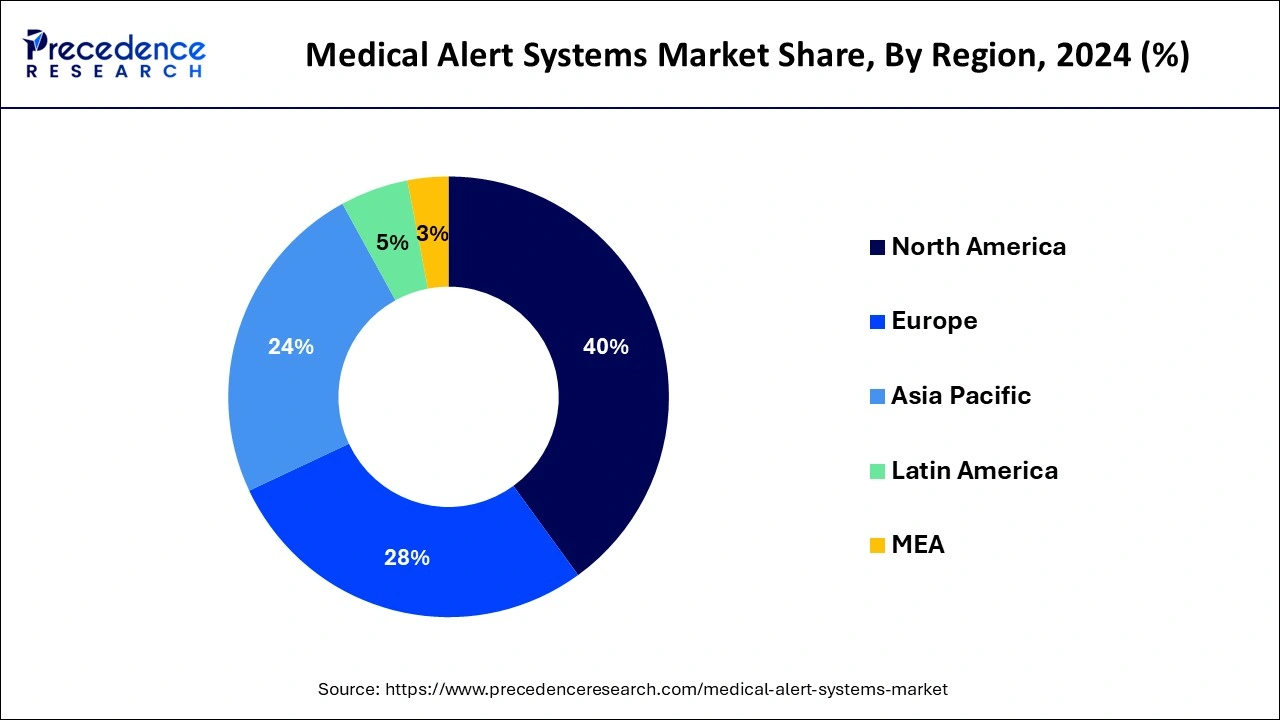List of Contents
Medical Alert Systems Market Size and Forecast 2025 to 2034
The global medical alert systems market size was calculated at USD 9.24 billion in 2024 and is predicted to increase from USD 10.27 billion in 2025 to approximately USD 26.27 billion by 2034, expanding at a CAGR of 11.01% from 2025 to 2034.

Medical Alert Systems Market Key Takeaways
- The global medical alert systems market was valued at USD 9.24 billion in 2024.
- It is projected to reach USD 26.27 billion by 2034.
- The medical alert systems market is expected to grow at a CAGR of 11.01% from 2025 to 2034.
- North America contributed more than 40% of revenue share in 2024.
- Asia-Pacific is estimated to expand the fastest CAGR between 2025 and 2034.
- By type, the personal emergency response systems (PERS) segment has held the largest market share of 38% in 2024.
- By type, the smart belt segment is anticipated to grow at a remarkable CAGR of 11.5% between 2025 and 2034.
- By technology, the unmonitored medical alert systems segment generated over 35% of revenue share in 2024.
- By technology, the IP-based systems segment is expected to expand at the fastest CAGR over the projected period.
- By application, the home-based users segment generated over 31% of revenue share in 2024.
- By application, the hospitals and clinics segment is expected to expand at the fastest CAGR over the projected period.
U.S. Medical Alert Systems Market Size andGrowth 2025 to 2034
The U.S. medical alert systems market size was exhibited at USD 2.55 billion in 2024 and is projected to be worth around USD 7.63 billion by 2034, growing at a CAGR of 11.58% from 2025 to 2034.

North America has held the largest revenue share of 40% in 2024. North America commands a substantial share in the medical alert systems market due to factors such as a rapidly aging population, heightened awareness of healthcare solutions, and advanced healthcare infrastructure. The region's well-established healthcare system encourages the adoption of medical alert systems for elderly care. Additionally, technological innovations, favorable reimbursement policies, and a proactive approach to health and safety contribute to the prominence of North America in this market, with a robust demand for personalized and technologically advanced emergency response solutions.
Asia-Pacific is estimated to witness the fastest growth. Asia-Pacific commands a significant share in the medical alert systems market due to a rising aging population, increasing prevalence of chronic diseases, and a growing awareness of healthcare solutions. Governments and healthcare providers in the region are emphasizing the importance of elderly care and remote patient monitoring, driving the adoption of medical alert systems. Additionally, advancements in technology, improving healthcare infrastructure, and a surge in disposable income contribute to the market's expansion, making Asia-Pacific a key player in the global medical alert systems market.

Market Overview
Medical alert systems are gadgets designed to provide swift assistance in emergencies, especially for people who live alone or face potential health challenges. These systems usually consist of a wearable item like a pendant or wristband with an activated button. Pressing the button connects the user to a monitoring center staffed by trained professionals capable of assessing the situation and dispatching help if necessary.
These systems offer a sense of assurance and independence, proving particularly valuable for seniors and those with ongoing health conditions. They have advanced features such as fall detection and GPS tracking, improving their ability to respond promptly to emergencies. Given the increasing aging population and the preference for independent living, medical alert systems play a vital role in ensuring the safety of individuals. They provide comfort to both users and their loved ones by offering a dependable and immediate response mechanism during critical times.
Medical Alert Systems Market Growth Factors
- The global increase in the aging population, especially in developed countries, is a significant growth factor for the medical alert systems market as seniors seek solutions for independent living with added safety.
- The prevalence of chronic health conditions, such as heart disease and diabetes, contributes to the growing demand for medical alert systems, providing individuals with quick access to emergency assistance.
- Continuous innovations, including improved sensors, GPS tracking, and connectivity options, enhance the functionality and appeal of medical alert systems, driving market growth.
- Growing awareness among consumers about the benefits of medical alert systems for immediate response during emergencies fuels market expansion.
- Supportive government initiatives and policies aimed at improving healthcare access for the elderly and vulnerable populations boost the adoption of medical alert systems.
- In rural areas with limited access to healthcare facilities, medical alert systems become crucial in bridging the gap by ensuring timely emergency response.
- The increase in lifestyle-related injuries, such as falls, prompts individuals to invest in medical alert systems for quick assistance and injury prevention.
- Medical alert systems contribute to healthcare cost savings by reducing the need for prolonged hospital stays, making them an attractive option for both individuals and healthcare providers.
- The integration of medical alert systems with smart home technologies enhances user convenience and safety, fostering market growth.
- The integration of medical alert systems with telehealth services supports remote patient monitoring, making them an integral part of modern healthcare solutions.
- The COVID-19 pandemic has heightened the awareness of health and safety, driving interest in medical alert systems as a precautionary measure.
- Favorable reimbursement policies from insurance providers encourage individuals to invest in medical alert systems, driving market expansion.
- The compatibility of medical alert systems with mobile apps facilitates seamless communication and real-time updates, attracting tech-savvy consumers.
- The incorporation of advanced fall detection technology addresses a critical need, especially among the elderly, contributing to the market's growth.
- Rising disposable income levels enable more individuals to afford medical alert systems, expanding the market's consumer base.
- The ability of medical alert systems to provide assistance globally is becoming essential for individuals who travel frequently or live in diverse geographical locations.
- Manufacturers offering customizable features in medical alert systems cater to diverse consumer preferences, stimulating market growth.
- Collaborations between medical alert system providers and healthcare institutions enhance service quality and reliability, driving market expansion.
- Urbanization and the associated lifestyle changes contribute to the market's growth as individuals in urban areas prioritize safety solutions like medical alert systems.
- Increasing consumer confidence in the effectiveness and reliability of medical alert systems encourages wider adoption, propelling market growth.
Market Scope
| Report Coverage | Details |
| Growth Rate from 2025 to 2034 | CAGR of 11.01% |
| Market Size in 2025 | USD 10.27 Billion |
| Market Size in 2024 | USD 9.24 Billion |
| Market Size by 2034 | USD 26.27 Billion |
| Largest Market | North America |
| Base Year | 2024 |
| Forecast Period | 2025 to 2034 |
| Segments Covered | Type, Technology, and Application |
| Regions Covered | North America, Europe, Asia-Pacific, Latin America, and Middle East & Africa |
Market Dynamics
Driver
Product customization and consumer confidence
The surge in market demand for medical alert systems is significantly driven by product customization, where manufacturers offer tailored features to meet diverse consumer needs. Customization allows users to select specific functionalities, ensuring that the medical alert system aligns with their unique requirements and preferences. This personalized approach enhances the overall user experience, increasing the appeal of these systems.
Whether it's specialized features for chronic health conditions or preferences in design and connectivity, product customization empowers consumers to choose a system that best suits their lifestyle, fostering a higher adoption rate and sustained market growth. The growing confidence in the reliability and effectiveness of medical alert systems plays a pivotal role in surging market demand.
As consumers become more assured of the systems' ability to provide immediate and accurate assistance during emergencies, they are more inclined to invest in these devices. Positive user experiences, testimonials, and advancements in technology contribute to building this confidence, assuring consumers that medical alert systems are a trustworthy and essential tool for personal safety. This increased trust and assurance drives higher adoption rates, expanding the market as individuals prioritize these systems for proactive emergency preparedness and peace of mind.
Restraint
Affordability concerns and technological barriers
Affordability remains a significant restraint in the medical alert systems market, affecting market demand. The cost associated with purchasing and subscribing to these systems can be prohibitive for individuals on fixed incomes or tight budgets. Affordability concerns may dissuade potential users from investing in these life-saving devices, limiting the market's reach.
Manufacturers and service providers must explore pricing strategies and potential subsidies to make these systems more accessible, addressing the financial barriers that hinder widespread adoption. Technological barriers pose a challenge to the market demand for medical alert systems, particularly among older demographics less familiar with advanced technologies.
The complexity of device operation, including setup and maintenance, can deter potential users, impacting market growth. To address technological barriers, industry stakeholders should prioritize user-friendly designs, conduct effective user training programs, and offer robust customer support. Simplifying the technology and ensuring ease of use can broaden the appeal of medical alert systems, overcoming resistance and encouraging broader adoption across diverse age groups.
Opportunity
Customized solutions for chronic conditions and user-friendly design
Tailoring medical alert systems to address specific chronic conditions presents a compelling opportunity in the market. By integrating specialized features that cater to the unique needs of individuals with conditions like diabetes, heart disease, or respiratory issues, providers can offer targeted solutions. This customization enhances the relevance and effectiveness of medical alert systems, making them more appealing to those with specific health concerns.
It not only meets the diverse needs of users but also positions these systems as indispensable tools for managing chronic health conditions, thereby expanding their market reach and adoption among specific demographic segments. The emphasis on user-friendly design represents a significant opportunity in the medical alert systems market. Creating intuitive interfaces, simple setup processes, and ergonomic device designs, especially catering to the elderly population, enhances accessibility and usability.
A focus on user-centric design encourages broader adoption, addressing concerns related to technological barriers. User-friendly features can include large buttons, clear displays, and streamlined connectivity, ensuring that individuals of all ages can easily incorporate these systems into their daily lives. This approach not only attracts new users but also fosters customer satisfaction and loyalty, driving market growth as positive user experiences contribute to word-of-mouth recommendations and increased market demand.
Type Insights
In 2023, the personal emergency response systems (PERS) segment held the highest market share of 38% based on the type. personal emergency response systems (PERS) are a type of medical alert system designed to provide immediate assistance during emergencies. Typically consisting of a wearable device with an alert button, PERS enables users to summon help quickly in the event of a fall or medical issue. Trends in the PERS segment involve the integration of advanced technologies such as fall detection, GPS tracking, and smart home connectivity, enhancing the overall functionality and appeal of these systems for users seeking personalized and comprehensive emergency response solutions.
The smart belt segment is anticipated to witness a significant CAGR of 11.5% during the projected period. The smart belt segment in the medical alert systems market refers to wearable belts equipped with advanced monitoring and alert functionalities. These innovative devices often incorporate sensors for fall detection, GPS tracking, and biometric data collection. The smart belts aim to provide a discreet and convenient solution for users, allowing them to maintain their daily activities while ensuring prompt assistance in case of emergencies.
A rising trend in the smart belt segment involves integration with smart home systems and mobile apps, enhancing connectivity and providing users with seamless access to emergency services. Additionally, manufacturers are focusing on ergonomic designs and user-friendly interfaces to enhance the overall user experience and drive adoption in diverse demographics.
Technology Insights
According to the technology, the unmonitored medical alert systems segment held a 35% revenue share in 2023. Smart unmonitored medical alert systems leverage advanced technology to provide users with emergency assistance without requiring professional monitoring. These systems often feature automatic fall detection, GPS tracking, and connectivity to mobile devices. Users can directly alert pre-selected contacts or emergency services in case of an incident. A notable trend in the medical alert systems market is the integration of smart, unmonitored systems with voice-activated technologies and home automation, enhancing user autonomy and convenience while maintaining a focus on proactive emergency response and user safety.
The IP-based systems segment is anticipated to witness the fastest growth over the projected period. IP-based systems in medical alert systems: IP-based systems in the medical alert market utilize Internet Protocol technology for communication. These systems transmit data over the internet, enabling seamless connectivity and real-time communication between users and monitoring centers. By leveraging IP technology, these systems offer enhanced reliability, faster response times, and potential integration with other smart devices, contributing to a more comprehensive and interconnected approach to healthcare.
The trend in the medical alert systems market is a shift towards IP-based solutions, driven by the increasing prevalence of high-speed internet connectivity and the desire for more efficient and interconnected healthcare technologies. IP-based systems provide opportunities for improved data transmission, remote monitoring, and advanced features, aligning with the broader technological advancements in the healthcare industry.
Application Insights
According to the application, the home-based segment users held a 31% revenue share in 2023. Home-based users in the medical alert systems market refer to individuals who predominantly use these systems within their homes. This includes seniors, those with chronic conditions, or individuals living independently.
The aim is to offer immediate assistance during emergencies, ensuring a sense of safety and autonomy within the familiar surroundings of their homes. Recent trends show a surge in home-based Medical Alert Systems incorporating advanced features like fall detection, GPS tracking, and seamless integration with smart home technologies, enhancing safety and connectivity for users within their living environments.
The hospitals and clinics segment is anticipated to witness the fastest growth over the projected period. Within hospitals and clinics, medical alert systems play a vital role in ensuring patient safety and swift emergency response. These systems are seamlessly incorporated into healthcare settings, offering immediate assistance during patient emergencies or falls. A notable trend is the growing utilization of advanced medical alert systems, integrated into hospital networks. This integration facilitates quicker response times, continuous patient monitoring, and seamless communication between healthcare providers and patients requiring urgent assistance, enhancing overall healthcare efficacy.
Medical Alert Systems Market Companies
- Philips Lifeline
- Medical Guardian
- ADT
- Life Alert
- Bay Alarm Medical
- MobileHelp
- GreatCall (acquired by Best Buy)
- Tunstall Healthcare
- Alert1
- Connect America
- LifeFone
- Rescue Alert
- Guardian Medical Monitoring
- Alert Sentry
- Valued Relationships Inc. (VRI)
Recent Developments
- In February 2021, Connect America collaborated with Urban Health Plan (US), a US-based health center program, to extend remote patient monitoring (RPM) services to residents in underserved communities across the Bronx, Queens, and Manhattan.
- In October 2020, MobileHelp introduced Micro, a comprehensive mobile medical alert device that combines wearable comfort with a compact and lightweight design while retaining robust technological features. The product includes MobileHelp's patented automatic fall detection and advanced location tracking technology.
Segments Covered in the Report
By Type
- Personal Emergency Response Systems (PERS)
- Nurse Calling Systems (NCS)
- Smart Belt
By Technology
- Two-way Voice Systems
- Unmonitored Medical Alert Systems
- Medical Alert Alarm (Button) System
- IP-based Systems
By Application
- Home-Based Users
- Senior Living Facilities/Senior Care Centers
- Assisted Living Facilities
- Hospitals and Clinics
- Others
By Geography
- North America
- Europe
- Asia-Pacific
- Latin America
- Middle East and Africa
For inquiries regarding discounts, bulk purchases, or customization requests, please contact us at sales@precedenceresearch.com
Frequently Asked Questions
Ask For Sample
No cookie-cutter, only authentic analysis – take the 1st step to become a Precedence Research client